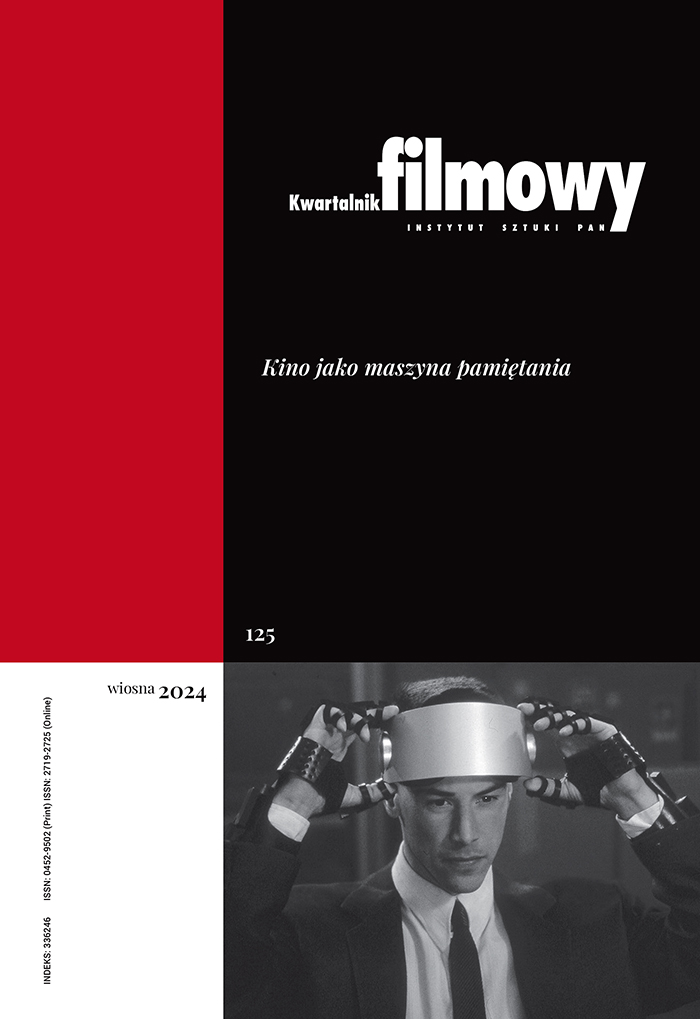Tylko jedno wspomnienie. Próba autobiografii bez narracji w pracach Billa Violi
Abstrakt
Prace Billa Violi, artysty działającego w sferze sztuki ruchomego obrazu, która jednak nie jest filmem, kwalifikowane są jako video art, video environments czy instalacje medialne. W pracach tych niezwykle często ujawniają się tropy autobiograficzne, choć sam artysta nigdy nie „opowiada”, nie wykorzystuje struktur klasycznej narracji. Raczej nadbudowuje sensy nad jednym, bardzo jednak ważnym wydarzeniem z czasów dzieciństwa, kiedy podczas zabawy w wodzie mały Bill Viola zaczął się topić. Doświadczenie to było w sposób oczywisty traumatyczne, ale jednocześnie fascynujące, bowiem doznał wtedy niezwykłych wrażeń wizualnych. Motywy nawiązujące do wypadku pojawiają się w twórczości Billa Violi niezwykle często – w różny jednak sposób i na odmiennych poziomach konceptualizacji. Scena z dzieciństwa powraca w sposób dosłowny, ale częściej jako próba dotarcia do „ukrytego wymiaru” zdarzenia. Doskonałym przykładem przepracowania wątku autobiograficznego jest należąca do kanonu sztuki nowych mediów taśma zatytułowana The Reflecting Pool. Ta praca stanowi podstawę analizy w tekście Pitrusa.
Słowa kluczowe:
Bill Viola, autobiografizm, sztuka wideoBibliografia
Biografistyka filmowa. Ekranowe interpretacje losów i faktów, red. T. Szczepański, S. Kołos, Wydawnictwo Adam Marszałek, Toruń 2007, s. 9.
Google Scholar
Boyle Deindre, Post-Traumatic Shock: Bill Viola's Recent Work, „Afterimage” 1996, nr 24 (Sept.–Oct. 1996), s. 10.
DOI: https://doi.org/10.1525/aft.1996.24.2.9
Google Scholar
Brewińska Maria, Świadomość medium, w: Bill Viola, red. M. Brewińska, Zachęta Narodowa Galeria Sztuki, Warszawa 2007, s. 92.
Google Scholar
Hendrykowski Marek, Biografizm jako dążenie kina współczesnego, w: Biografistyka filmowa. Ekranowe interpretacje losów i faktów, red. T. Szczepański, S. Kołos, Wydawnictwo Adam Marszałek, Toruń 2007, s. 13.
Google Scholar
Lubiak Jarosław, Zawieszenie uczuć, w: Bill Viola, red. M. Brewińska, Zachęta Narodowa Galeria Sztuki, Warszawa 2007, s. 111-112.
Google Scholar
Pitrus Andrzej, „The Reflecting Pool“ Billa Violi – wymiary obrazu wideo, „Kwartalnik Filmowy“ 2008, nr 64, s. 94-102.
Google Scholar
Walsh John, Emotions in extreme time: Bill Viola’s passion project, w: B. Viola, P. Sellars, J. Walsh, H. Belting, Bill Viola: The passions, The J. Paul Getty Museum, Los Angeles 2003, s. 50.
Google Scholar
Autorzy
Andrzej Pitruskwartalnik.filmowy@ispan.pl
Uniwersytet Jagielloński Polska
Pracownik naukowy Instytutu Sztuk Audiowizualnych UJ. Autor książek Gore, seks, ciało, psychoanaliza (1992), Kino kultu (1998), Zrozumieć reklamę (1999), Znaki na sprzedaż (2000). Nam niebo pozwoli. O filmowej i telewizyjnej twórczości Todda Haynesa (2004), Filmowcy i kiniarze (2004), Dotykając lustra. Melodramaty Douglasa Sirka (2006). Znawca problematyki kina niezależnego.
Statystyki
Abstract views: 722PDF downloads: 126
Licencja
Prawa autorskie (c) 2011 Andrzej Pitrus

Utwór dostępny jest na licencji Creative Commons Uznanie autorstwa 4.0 Międzynarodowe.
Autor bądź autorka udziela wydawcy niewyłącznej i nieodpłatnej licencji (CC BY 4.0) na wykorzystanie tekstu w „Kwartalniku Filmowym”, zachowuje nieograniczone prawa autorskie i zobowiązuje się do podawania miejsca pierwodruku przy ponownym wykorzystaniu artykułu (umowa licencyjna do pobrania). Czasopismo jest wydawane na licencji CC BY 4.0. Zgłaszając artykuł do publikacji, autor bądź autorka wyraża zgodę na jego udostępnianie na tej licencji.
W wydaniach od 105-106 (2019) do 119 (2022) wszystkie artykuły były publikowane na licencji CC BY-NC-ND 4.0. W tym okresie autorzy i autorki udzielali(-ły) niewyłącznej i nieodpłatnej licencji (CC BY-ND 4.0) na wykorzystanie tekstu w „Kwartalniku Filmowym”, zachowywali(-ły) nieograniczone prawa autorskie i zobowiązywali(-ły) się do podawania miejsca pierwodruku przy ponownym wykorzystaniu artykułu.
Inne teksty tego samego autora
- Andrzej Pitrus, Mama naga. Nagie ciało matki we współczesnych sztukach wizualnych , Kwartalnik Filmowy: Nr 83-84 (2013): Ciało w filmie
- Andrzej Pitrus, Chrisa Markera podróże w czasie: o dziwnych losach „La Jetée” , Kwartalnik Filmowy: Nr 89-90 (2015): Redefinicje klasyki
- Andrzej Pitrus, Pozbawiony tytułu esej o podróży do domu, którego nie ma i może nigdy nie będzie, albo do domu, który kiedyś należał do kogoś zupełnie innego , Kwartalnik Filmowy: Nr 107 (2019): Podróż, (e)migracja, pielgrzymka
- Andrzej Pitrus, Pozbawiony tytułu esej o państwie, które odwróciło się od własnych dzieci , Kwartalnik Filmowy: Nr 105-106 (2019): Kino wobec transformacji ustrojowych
- Andrzej Pitrus, To my wymyśliliśmy czas. „Ocean Without a Shore” i „Transfigurations” Billa Violi , Kwartalnik Filmowy: Nr 86 (2014): Wymiary czasu
- Andrzej Pitrus, Kino bez tajemnic , Kwartalnik Filmowy: Nr 75-76 (2011): Oblicza rzeczywistości
- Andrzej Pitrus, Zamknięte przestrzenie Billa Violi , Kwartalnik Filmowy: Nr 79 (2012): Wnętrza. O filmowej przestrzeni zamkniętej
- Andrzej Pitrus, Rozliczenia z kinem niemieckim , Kwartalnik Filmowy: Nr 80 (2012): Film na styku kultur
- Andrzej Pitrus, Nieznane i znane formy , Kwartalnik Filmowy: Nr 87-88 (2014): Film i teatr
- Andrzej Pitrus, Oko w oko ze zwierzęciem: „I Do Not Know What It Is I Am Like” i międzykulturowe negocjacje Billa Violi , Kwartalnik Filmowy: Nr 80 (2012): Film na styku kultur











